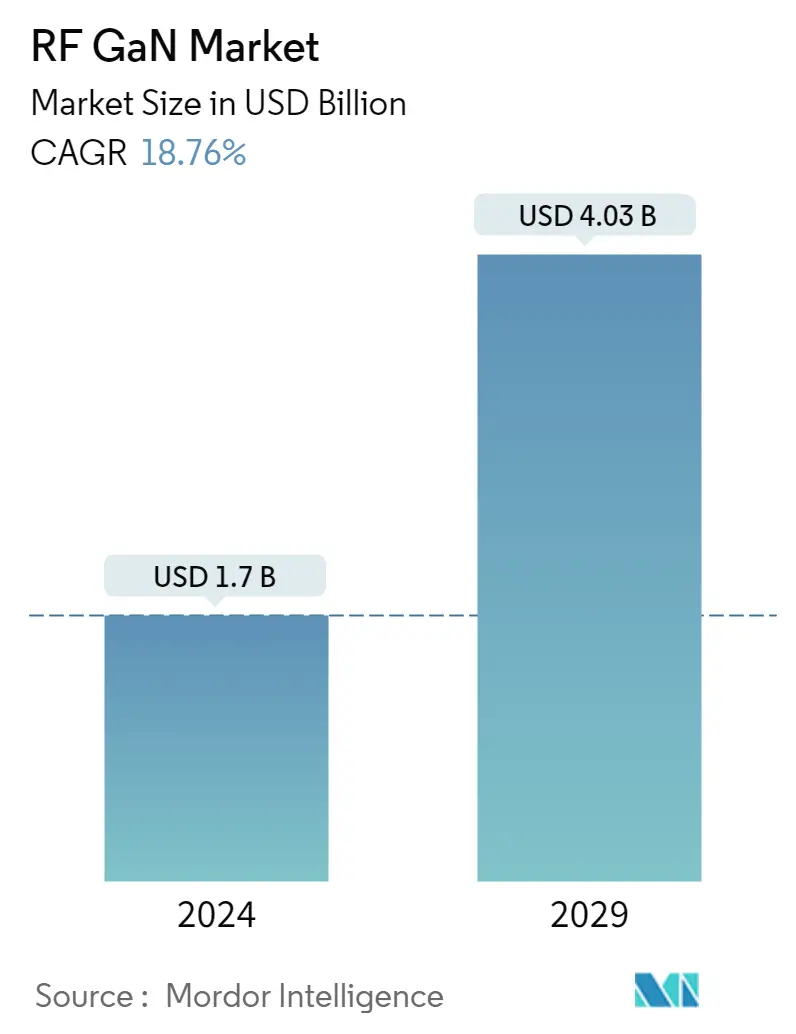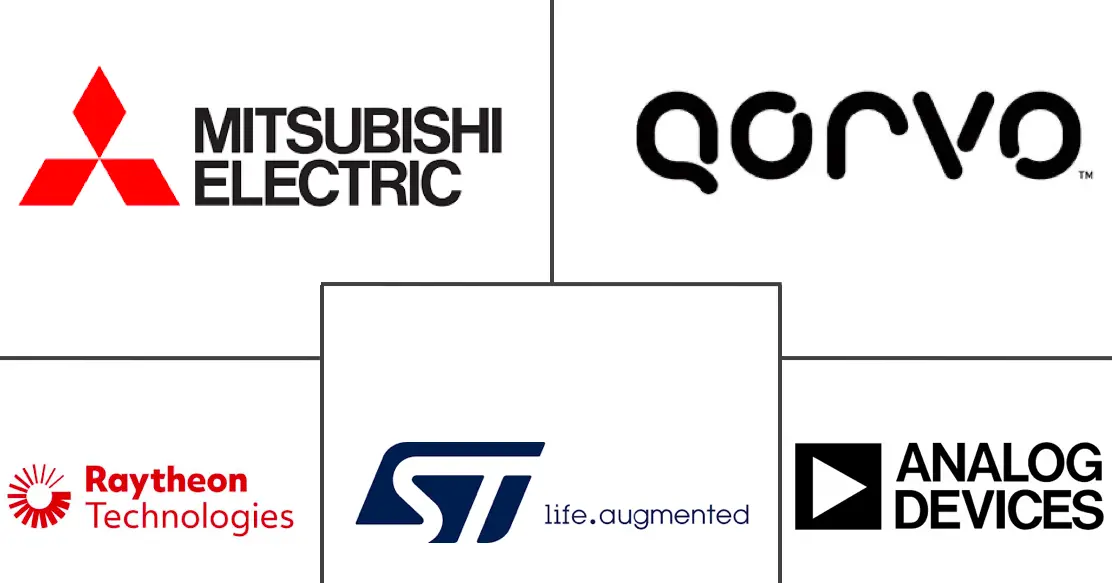Market Size of RF GaN Industry

| Study Period | 2019 - 2029 |
| Market Size (2024) | USD 1.70 Billion |
| Market Size (2029) | USD 4.03 Billion |
| CAGR (2024 - 2029) | 18.76 % |
| Fastest Growing Market | Asia Pacific |
| Largest Market | North America |
| Market Concentration | Medium |
Major Players
*Disclaimer: Major Players sorted in no particular order |
Radiofrequency Gallium Nitride Market Analysis
The RF GaN Market size is estimated at USD 1.7 billion in 2024, and is expected to reach USD 4.03 billion by 2029, growing at a CAGR of 18.76% during the forecast period (2024-2029).
Due to the benefits of RF GaN usage across a wide range of real-time linked devices and applications, more industries are expected to use the Internet of Things (IoT) technology, which is expected to drive market growth. With the continuously evolving GaN technology, GaN enables higher frequencies in more complex applications, such as phased arrays, radar, and base transceiver stations for cable TV (CATV), very small aperture terminal (VSAT), and defense communications.
- RF GaN plays a key role in wireless infrastructure, improving efficiency and expanding bandwidth to support ever-increasing data transmission speeds. The market for RF GaN is primarily driven by increasing 5G adoption and advances in wireless communications. Telecom operators could also benefit from increased use of GaN power transistors.
- The increasing adoption of RF GaN in electric automotive is also one of the major factors driving demand in this market. Silicon carbide devices are used in the onboard battery chargers of electric buses, taxis, lorries, and passenger cars. Further, increasing government laws favoring the electric vehicles market stimulates demand in the RF GaN market.
- The infrastructure needed to create autonomous vehicles and drones is another factor that increases demand for RF GaN technologies. Hence, growth in the adoption and development of autonomous vehicles and drones for various applications, especially military and defense, is expected to increase further the adoption of RF GaN devices over the forecast period.
- The inherent material advantages of GaN come with some associated manufacturing challenges that include the cost and optimization of device processing and packaging. Other issues include charge trapping and current collapse, which need to be resolved for increased adoption of these devices. Although significant improvements have been made in RF GaN-based devices (performance and yields), there are still some barriers preventing the gallium nitride on silicon carbide (GaN-on-SiC) from entering mainstream applications (i.e., in wireless telecom base-stations or CATV).
- The COVID-19 pandemic impacted supply lines and the telecoms industry. It considerably hindered the penetration of 5G in the telecommunications sector. In this critical situation, consumers are expected to continue using mobile phones, but most of them may not be able to invest more in a technology that is still in a nascent stage.
- Rapidly increasing data consumption has resulted in the growth of commercial networks and is encouraging network providers to adopt next-generation networks, such as 4G and 5G. According to the Cisco Visual Networking Index, global mobile data traffic is expected to register a CAGR of 46%, reaching 77.5 exabytes per month by 2022.
- Organizations across the world are innovating new products and expanding their business. For instance, in June 2022, Integra, a provider of innovative RF and microwave power solutions, announced that it had begun shipping its breakthrough 100V RF GaN technology to customers in the United States and Europe. The company also announced the expansion of its 100V RF GaN product portfolio with the launch of seven new products for the avionics, directed energy, electronic warfare, radar, and scientific market segments, delivering power levels of up to 5kW in a single transistor.
Radiofrequency Gallium Nitride Industry Segmentation
GAN stands out in RF applications because of several reasons, such as high breakdown field, high saturation velocity, and robust thermal properties, as they have been instrumental in transmitting signals over long distances or at high-end power levels.
This report segments the market by Application (Military, Telecom Infrastructure, Satellite Communication, Wired Broadband, Commercial Radar and Avionics, and RF Energy), Material (GaN-on-Sic and GaN-on-Silicon), and Geography (North America, Europe, Asia-Pacific, and Middle East and Africa). The market sizes and forecasts are provided in terms of value (USD million) for all the above segments.
| By Application | |
| Military | |
| Telecom Infrastructure (Backhaul, RRH, Massive MIMO, Small Cells) | |
| Satellite Communication | |
| Wired Broadband | |
| Commercial Radar and Avionics | |
| RF Energy |
| By Material Type | |
| GaN-on-Si | |
| GaN-on-SiC | |
| Other Material Types (GaN-on-GaN, GaN-on-Diamond) |
| Geography | |
| North America | |
| Europe | |
| Asia Pacific | |
| Middle East and Africa |
RF GaN Market Size Summary
The RF GaN market is poised for significant growth, driven by its increasing adoption across various industries and applications. The technology's ability to enhance efficiency and expand bandwidth makes it a crucial component in the development of advanced wireless infrastructure, particularly with the rise of 5G and IoT technologies. RF GaN is integral to supporting higher frequencies in complex applications such as phased arrays, radar, and defense communications. The market's expansion is further fueled by the growing demand for electric vehicles and autonomous systems, which rely on RF GaN for improved performance and efficiency. Despite challenges in manufacturing and device optimization, ongoing innovations and strategic partnerships are expected to overcome these barriers, facilitating broader adoption in mainstream applications.
The Asia-Pacific region plays a pivotal role in the RF GaN market, with countries like China, Japan, and South Korea leading the charge in semiconductor development. The region's dominance is bolstered by significant investments in 5G infrastructure and a shift towards innovation-driven economies, particularly in China. The Indian market is also emerging as a key player, supported by government initiatives like 'Make in India' and advancements in semiconductor technology. The competitive landscape is marked by high rivalry among major players such as Raytheon Technologies and STM Microelectronics, who continue to innovate and expand their offerings. Collaborations and strategic developments, such as those by Qorvo and STMicroelectronics, are enhancing the market's growth prospects, particularly in defense and telecommunications applications.
RF GaN Market Size - Table of Contents
-
1. MARKET INSIGHTS
-
1.1 Market Overview
-
1.2 Industry Value Chain Analysis
-
1.3 Industry Attractiveness - Porter's Five Forces Analysis
-
1.3.1 Threat of New Entrants
-
1.3.2 Bargaining Power of Buyers
-
1.3.3 Bargaining Power of Suppliers
-
1.3.4 Threat of Substitute Products
-
1.3.5 Intensity of Competitive Rivalry
-
-
1.4 Technology Snapshot
-
1.5 Assessment of the Impact of COVID-19 on the Industry
-
-
2. MARKET SEGMENTATION
-
2.1 By Application
-
2.1.1 Military
-
2.1.2 Telecom Infrastructure (Backhaul, RRH, Massive MIMO, Small Cells)
-
2.1.3 Satellite Communication
-
2.1.4 Wired Broadband
-
2.1.5 Commercial Radar and Avionics
-
2.1.6 RF Energy
-
-
2.2 By Material Type
-
2.2.1 GaN-on-Si
-
2.2.2 GaN-on-SiC
-
2.2.3 Other Material Types (GaN-on-GaN, GaN-on-Diamond)
-
-
2.3 Geography
-
2.3.1 North America
-
2.3.2 Europe
-
2.3.3 Asia Pacific
-
2.3.4 Middle East and Africa
-
-
RF GaN Market Size FAQs
How big is the RF GaN Market?
The RF GaN Market size is expected to reach USD 1.70 billion in 2024 and grow at a CAGR of 18.76% to reach USD 4.03 billion by 2029.
What is the current RF GaN Market size?
In 2024, the RF GaN Market size is expected to reach USD 1.70 billion.

